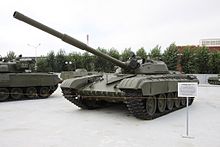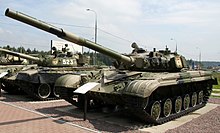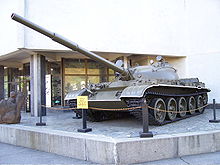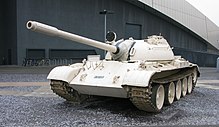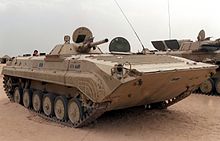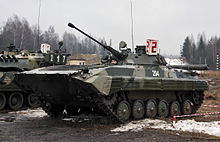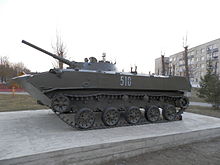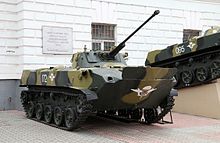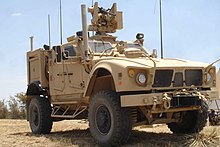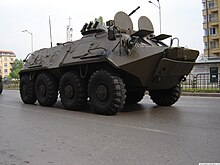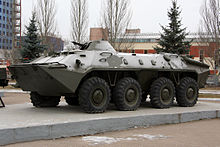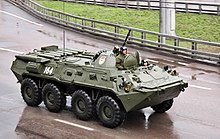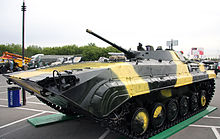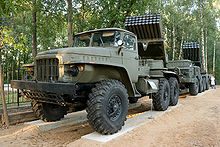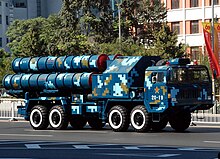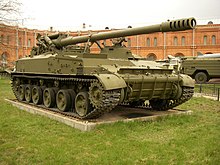Armed Forces of the Republic of Uzbekistan
| Armed Forces of the Republic of Uzbekistan | |
|---|---|
| Oʻzbekiston Respublikasi Qurolli Kuchlari | |
 Standard of the Armed Forces (Cyrillic) | |
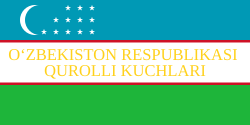 Standard of the Armed Forces (Latin) | |
| Founded | 14 January 1992 |
| Service branches | Uzbek Ground Forces Uzbek Air and Air Defence Forces Uzbek Naval Forces Uzbek Frontier Service Uzbek National Guard |
| Headquarters | Tashkent, Uzbekistan |
| Leadership | |
| President of Uzbekistan | Shavkat Mirziyoyev |
| Minister of Defense | Major General Abdusalom Azizov |
| Chief of the General Staff | Lieutenant-General Shavkat Normatov |
| Personnel | |
| Conscription | 18 years of age for compulsory military service; conscript service obligation - 12 months |
| Available for military service | 6,340,220 males, age 18-49 (2005 est.), 6,432,072 females, age 18-49 (2005 est.) |
| Fit for military service | 4,609,621 males, age 18-49 (2005 est.), 5,383,233 females, age 18-49 (2005 est.) |
| Reaching military age annually | 324,722 males (2005 est.), 317,062 females (2005 est.) |
| Active personnel | 65,000[1] |
| Expenditures | |
| Percent of GDP | 2% (2005 est.) Another reported figure is 3.7% |
| Industry | |
| Foreign suppliers | |
| Related articles | |
| Ranks | Rank insignia |
The Armed Forces of the Republic of Uzbekistan (Uzbek: Oʻzbekiston Respublikasi Qurolli Kuchlari), is the name of the unified armed forces of Uzbekistan, consisting of a Ground force, Air and Air Defense forces, National guard [2] a Frontier service.[3] and a Navy.They are reported to be the largest, and the strongest in Central Asia.[4]
Tashkent, the capital of Uzbekistan, used to be the headquarters of the Soviet Turkestan Military District and on 20 February 1992, the new Ministry of Defence Affairs took over the offices which had been formerly occupied by the district headquarters staff.[5] On 2 July 1992 a Presidential Decree established a Ministry of Defence to supersede the Ministry of Defence Affairs. Over the succeeding years, Uzbekistan replaced Russian officers with ethnic Uzbeks and restructured the military to focus on targets like civil unrest, drug trafficking, and Hizb-ut-Tahrir.[citation needed]
Uzbekistan and Russia signed a mutual defence pact in 2005, that will also result in closer military cooperation. This marked a stark contrast to a few years earlier, when the US appeared to be Uzbekistan's favoured foreign friend, and relations with Russia were cooler.[6]
'The country [has] also began professionalizing its military, an effort that has only limited success and erratic government support. But even in Uzbekistan, these changes represent merely a modest beginning and most of the benefits are concentrated in a few elite, higher readiness formations rather than uniformly applied to the entire force. The Uzbek military is woefully inadequate, but it is far superior to its neighbours.'[7] Uzbekistani military, by far, is alongside Kazakhstan, are both wealthy and quickly developed arms.
The government maintains a command and staff college for the military in Tashkent, based on the former Soviet TVOKU higher command college.
Activities and foreign relations
After the September 11, 2001 attacks, the United States leased the Karshi-Khanabad airbase in southern Uzbekistan, which borders Afghanistan. The American base there was called "Camp Stronghold Freedom," yet was more often referred to as "K2 Airbase" by the personnel in theater.
In May 2005, the military was involved in suppressing unrest in the Ferghana Valley city of Andijan, which became known as the Andijan massacre. Consequently, the EU banned arms sales and imposed a one-year visa ban on 12 senior officials, including the security chief and interior and defence ministers, accusing them of bearing responsibility for the killings.[8]
In the aftermath of the incident, President Karimov dismissed several senior military figures: Defense Minister Kadyr Gulyamov, Head of the Joint Headquarters of the Armed Forces Ismail Ergashev, and Commander of the Eastern military district Kosimali Akhmedov. Burnashev and Chernykh said that '..although these dismissals did not change the formal system of administration in the security and military structures, they reflected serious shifts in power relations among regional elites representing their clans.'[9]
A joint statement of the member countries of the Shanghai Co-operation Organisation issued in early July, 2005 on a conference in Astana (Kazakhstan) called for a withdrawal of US troops from military bases in Central Asia. On July 29, 2005, Uzbekistan invoked a provision asking the U.S. to leave within 180 days. On November 21, 2005, the withdrawal of US troops from Karshi-Khanabad and any other bases was completed.[10]
The European Union lifted the arms sales ban in 2009.
Arms control and non-proliferation
The government has accepted the arms control obligations of the former Soviet Union, and acceded to the Nuclear Non-Proliferation Treaty as a non-nuclear state. It has also supported an active program by the U.S. Department of Defense Defense Threat Reduction Agency in western Uzbekistan (Nukus and the biological warfare test laboratory on Vozrozhdeniye Island).
Land Forces
Organisation

The army includes five military districts, the Northwest at Nukus, the Southwest Special Military District at Karshi, the Central Military District at Dzhizak, and the Eastern Military District at Ferghana. In 2001, the Tashkent garrison was transformed into the Tashkent Military District.[11]
The headquarters of the military districts and their areas of responsibility are confirmed.
| District | Headquarters Location | Notes |
|---|---|---|
| Northwest Military District | HQ Nukus | Karakalpakstan, Xorazm Province |
| Southwest Special Military District | HQ Karshi | Qashqadaryo Province, Surxondaryo Province, Bukhara Province, Navoiy Province |
| Central Military District | HQ Dzhizak | Dzhizak Province, Samarqand Province, Sirdaryo Province |
| Eastern Military District (EMD) | Ferghana | Fergana Province, Andijan Province, Namangan Province |
| Tashkent Military District | HQ Tashkent | Tashkent Province, Established 2001 |
List of Formations

Army Headquarters (Tashkent)
- General Staff of the Armed Forces
- Honor Guard Battalion of the Tashkent Military District
- Engineering Brigade
- Special Forces Battalion
Regular Army
- Training Regiment (Chirchik)
- 387th Airborne Training Regiment[13]
- 17th Air Assault Brigade at (Fergana)[12] - 5000 soldiers
- 1st Motor Rifle Brigade (Chirchik)
- 2nd Motor Rifle Brigade (Samarqand)
- 3rd Motor Rifle Brigade (Termez)
- 25th Motor Rifle Brigade (Karshi)
- 37th Motor Rifle Brigade (Andijan)[14]
- Tank Regiment (Ahargaran)
Exercises


From August to September 1997, Uzbekistan took part in the exercises of the Central Asian Battalion (CENTRASBAT) in Kazakhstan and Uzbekistan. as part of an eight nation joint exercise which inude the United States, Russia and Ukraine.[15][16][17]
Uzbek troops participated in Partnership for Peace Exercise Cooperative Osprey '96 at Camp Lejeune in North Carolina, hosted by the United States Marine Corps. They then participated as well in Exercise Cooperative Osprey '98.
In September 2004, the (then) Royal Welsh Regiment (now 3rd Bn The Royal Welsh) of the British Army participated with the Uzbek Army Peacekeeping Battalion in "Exercise Timurlane Express" in the Farish Mountain Training Area.[citation needed] This was a 3-week NATO sponsored Partnership for Peace training exercise.
Current equipment
Reportedly, Uzbek armed forces' small arms include the AK-47, AK-74, Dragunov sniper rifle, Makarov PM pistol, and PK.
Air Forces
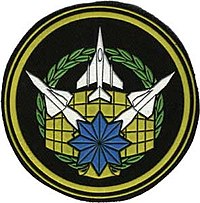
The Uzbek air forces consist of units formerly part of the 49th Air Army of the Turkestan Military District headquartered at Tashkent. There are two remaining combat units, brigades at Karshi-Khanabad and Dzhizak.[12]
The 60th Separate Brigade is the former 735th Bomber Aviation Regiment combined with the former 87th Separate Reconnaissance Aviation Regiment.[22] It has 31 Su-24s, 32 MiG-29s, and 6 Su-27s. Other recently disbanded units include the 61st Fighter Aviation Regiment at Kakaydy, which was itself a merger with the previous 115th Fighter Aviation Regiment, and the 62nd Fighter Aviation Regiment at Andijan. Regiments at both bases were disbanded in 1999. As many as 26 stored Su-17s, apparently in very bad condition, remain at Chirchiq (see Google Earth 41°30'05.69"N 69°33'44.90"E).
List of units
- 60th Separate Mixed Aviation Brigade (Karshi-Khanabad)(60 BAP), Su-24/Su-24MR, Su-27- (31 Su-24, 32 MiG-29, 6 Su-27, 1200 personnel.)
- Separate Mixed Aviation Brigade, Dzhizak, Su-25 - (Su-25, L-39, Mi-8, Mi-24)
- Separate Mixed Aviation Regiment, Fergana, Аn-12, 12РР, 26, 26РР
- Separate Mixed Aviation Squadron, Tashkent, Аn-24, Тu-134
- 65th Separate Helicopter Regiment Kagan, Bukhara Mi-6,8. According to the IISS Military Balance 2002- 28 Mi-6, 29 Mi-8. Former 396th Separate Helicopter Regiment, Southern Group of Forces
- 66th Separate Helicopter Regiment, Chirchiq, Mi-8/24/26 helicopters. The IISS Military Balance 2002 listed Uzbekistan with 42 Mi-24, 29 Mi-8,1 Mi-26
- 12th Anti-Aircraft Rocket Brigade
- Radio-Technical Brigade


Current air force equipment
| Aircraft | Origin | Type | Versions | In service | Notes |
|---|---|---|---|---|---|
| Sukhoi Su-27 | Multi role fighter | 25 | |||
| Sukhoi Su-24 | Long-range bomber | 32 | Stored | ||
| Mikoyan MiG-29 | Multi role fighter | 60[23] | |||
| Sukhoi Su-17 | Ground attack | 38 | Stored | ||
| Sukhoi Su-25 | Ground attack | 25 | Active | ||
| Aero L-39 Albatros | Light attack/ trainer | 14 | |||
| Ilyushin Il-76 | Heavy transport | 6 | |||
| An-12 | Medium transport | 5 | |||
| An-24 | Medium transport | 1 | |||
| An-26 | Medium transport | 15 | |||
| Boeing 767-300 | VIP Transport | 1 | UK-67000, governmental plane | ||
| Boeing 757-200 | VIP Transport | 1 | UK-75700, governmental plane | ||
| Mi-24 Hind | Heavy attack helicopter | 51 | |||
| Mi-8 Hip/Mi-17 Hip | Medium transport helicopter | 64 | |||
| Mil Mi-6 | Heavy transport helicopter | 27 | |||
| Mil Mi-26 | Heavy transport helicopter | 1 |
Border Guard
The Frontier Service, also called the Committee for State Border Protection of the National Security Service, is the border guard of Uzbekistan. They have gotten into disagreements with the Kyrgyz Frontier Force in the Batken Region.[24] The Frontier Service also operates the riverine naval assets of Uzbekistan, which include two Gyurza class gunboats.[25]
Special Forces
The military, NSS, and MIA maintain several spetsnaz battalions, including Scorpion Group, Bars GBars, and Alpha Group. They are commonly used against Islamic terrorists in the border regions near Tajikistan and Kyrgyzstan.[26]
Military Academies

- Academy of the Armed Forces of Uzbekistan
- Higher Military Customs Institute
- Tashkent Higher All-Arms Command School
- Tashkent Higher Tank Command School
- Samarkand Higher Military Automobile Command School
- Academy of the Ministry of Internal Affairs of Uzbekistan
- Military-Technical Institute of the National Guard of Uzbekistan
References
- ^ John Pike. "Uzbekistan - Security Policy". Retrieved 23 October 2014.
- ^ John Pike. "Uzbekistan- Army". Retrieved 23 October 2014.
- ^ "The World Factbook". Retrieved 23 October 2014.
- ^ "Today.Az » Politics » Uzbekistan would prefer to be policeman of Central Asia: expert". Retrieved 23 October 2014.
- ^ Richard Woff, 'Independence and the Uzbek Armed Forces,' Jane's Intelligence Review, December 1993, p.567
- ^ BBC, [1]
- ^ McDermott, JSMS, 2002, p.30
- ^ "BBC". BBC News. Retrieved 23 October 2014.
- ^ Rustam Burnashev and Irina Chernykh, Changes in Uzbekistan's Military Policy After the Andijan Events Archived 2009-03-26 at the Wayback Machine, China and Eurasia Forum Quarterly, Volume 5, No. 1 (2007), Central Asia-Caucasus Institute & Silk Road Studies Program, ISSN 1653-4212, p. 72
- ^ US Completes Withdrawal From Uzbek Base
- ^ Bakhtiyar Kamilov, Formation of Conceptual Approaches to the Problems of Ensuring National Security in Central Asian States - Uzbekistan, Kazakhstan, Kyrgyzstan, Tajikistan and Turkmenistan
- ^ a b c "Archived copy". Archived from the original on 2007-10-18. Retrieved 2007-09-29.
{{cite web}}: Unknown parameter|deadurl=ignored (|url-status=suggested) (help)CS1 maint: archived copy as title (link), accessed late September 2007 and June 2010 - ^ "Archived copy" (PDF). Archived from the original (PDF) on 2009-03-26. Retrieved 2013-03-25.
{{cite web}}: Unknown parameter|deadurl=ignored (|url-status=suggested) (help)CS1 maint: archived copy as title (link) - ^ Press-service of the President of the Republic of Uzbekistan: Islam Karimov: no one can turn us from our chosen path Archived 2012-09-10 at archive.today
- ^ https://www.globalsecurity.org/military/ops/centrasbat.htm
- ^ https://www.upi.com/Archives/1997/09/14/CENTRAZBAT-97-set-to-get-underway/2357874209600/
- ^ https://www.rferl.org/amp/1086503.html
- ^ a b c d e f g h i j k l m n o p q r s t u [↑ The International Institute For Strategic Studies IISS The Military Balance 2010. — Nuffield Press, 2010. — С. 373. — ISBN 978-1-85743-557-3.]
- ^ [2] the-military-balance-2016 —
- ^ Пентагон завершит поставки Узбекистану бронетехники в ближайшее время Archived 2015-07-19 at the Wayback Machine — 12news.uz, 15.06.2015
- ^ [3] thediplomat.com
- ^ For 735th Bomber Aviation Regiment, see Michael Holm, [4], and for 87th Separate Reconnaissance Aviation Regiment, see [5]
- ^ "World Military Aircraft Inventory". 2011 Aerospace: Aviation Week and Space Technology, January 2011.
- ^ "Uzbekistan's Frontier Service: Kyrgyzstan aggravates situation in Sokh enclave". Trend. 10 August 2011. Retrieved 23 October 2014.
- ^ http://www.navyrecognition.com/index.php/news/defence-news/year-2014-news/december-2014-navy-naval-forces-maritime-industry-technology-security-global-news/2293-ukraine-resumed-construction-of-gyurza-m-project-58155-river-armored-artillery-boats.html
- ^ "Archived copy". Archived from the original on 2013-08-18. Retrieved 2013-10-04.
{{cite web}}: Unknown parameter|deadurl=ignored (|url-status=suggested) (help)CS1 maint: archived copy as title (link)
Further reading
- Roger N. McDermott, The armed forces of the republic of Uzbekistan 1992-2002: Threats, influences and reform, The Journal of Slavic Military Studies, Volume 16, Issue 2 June 2003, pages 27 – 50
External links
| External image | |
|---|---|

